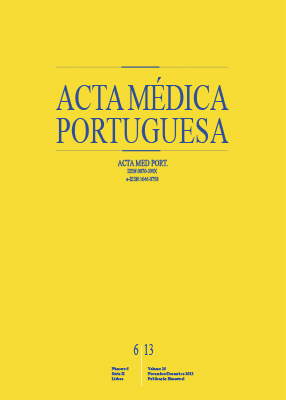Contribution for the Validation of the Portuguese Version of EQ-5D
DOI:
https://doi.org/10.20344/amp.1317Abstract
Introduction: The EQ-5D allows the achievement of two essential components of any measure of health-related quality of life to be used in cost-utility economic evaluations: (i) a profile describing the health status in terms of domains or dimensions; and (ii) a numeric value associated with the health status described.Aim: The Portuguese version of the EQ-5D questionnaire was completed in 1998, based on guidelines set by the EuroQol Group, including translation and back translation procedures. Despite its wide use in Portugal, until now it had not yet been published studies that initially led to the Portuguese version and the guarantee of acceptability, reliability and validity. The purpose of this article is to document these first values relating to the Portuguese version of the EQ-5D.
Material and Methods: We used three different samples: a first one with 1,500 individuals representative of the Portuguese population; a second with 140 individuals just intended for the reliability test; and a third sample with 643 individual patients with cataracts, asthma, chronic obstructive pulmonary disease, or rheumatoid arthritis.
Results: The acceptability was assessed by the number of missing responses. It was also found a marked ceiling effect, with a large part of the sample not reporting any problems in the dimensions of the EQ-5D.
Discussion: The construct validity was tested by examining the degree to which low values of EQ-5D were positively associated with increasing age, being female, and the sick, as well as the values of dimensions of the SF-36v2 scale. Convergent validity was based on correlations between EQ-5D values and other specific measures. The EQ-5D showed moderate to high correlations with other diseasespecific measures of health status and health related quality of life.
Conclusion: We can state that the Portuguese version of the EQ-5D has a good accessibility, reliability and validity in measuring
health.
Downloads
Downloads
Published
How to Cite
Issue
Section
License
All the articles published in the AMP are open access and comply with the requirements of funding agencies or academic institutions. The AMP is governed by the terms of the Creative Commons ‘Attribution – Non-Commercial Use - (CC-BY-NC)’ license, regarding the use by third parties.
It is the author’s responsibility to obtain approval for the reproduction of figures, tables, etc. from other publications.
Upon acceptance of an article for publication, the authors will be asked to complete the ICMJE “Copyright Liability and Copyright Sharing Statement “(http://www.actamedicaportuguesa.com/info/AMP-NormasPublicacao.pdf) and the “Declaration of Potential Conflicts of Interest” (http:// www.icmje.org/conflicts-of-interest). An e-mail will be sent to the corresponding author to acknowledge receipt of the manuscript.
After publication, the authors are authorised to make their articles available in repositories of their institutions of origin, as long as they always mention where they were published and according to the Creative Commons license.









